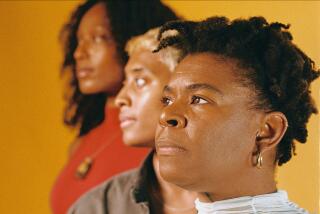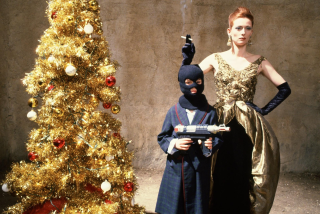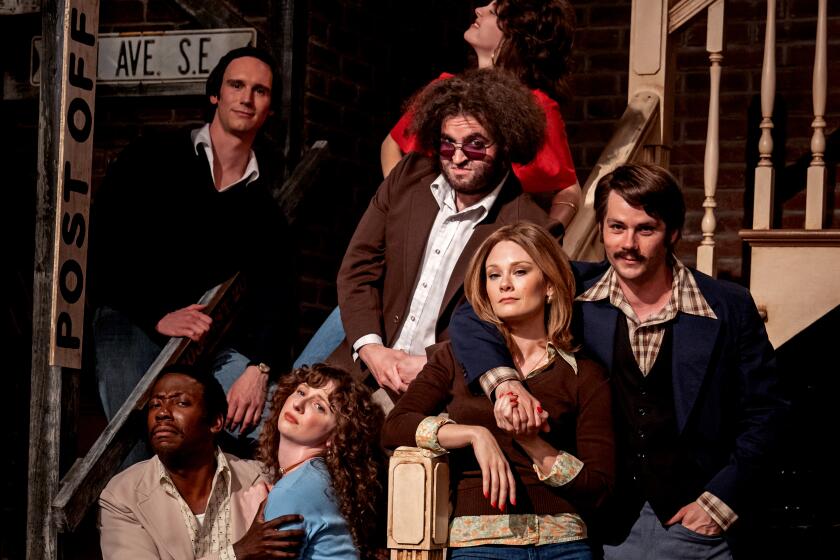In 1963, jazz pianist Herbie Hancock was playing a show with Miles Davis when, during Davis’ solo, he played the wrong chord.
Shamed, he froze for about a minute. “Miles paused for a second and then he played some notes that made my chord right,” Hancock recalled. “[He] was able to make something that was wrong into something that was right with the power of the choice of notes that he made and the feeling that he had.
“What I realize now is that Miles didn’t hear it as a mistake. He heard it as something that happened, an event. That was just part of the reality of what was happening at that moment and he dealt with it. He felt it was his responsibility to find something that fit.”
That classic slice of jazz history became one of the guiding lights for Joe Gardner, the 45-year-old Black protagonist of Pixar’s “Soul.” The Disney subsidiary’s 23rd feature film, and first with a Black lead, was directed by the studio’s chief creative officer Pete Docter and co-directed by playwright Kemp Powers.
Hancock’s memory of Davis was “a perfect metaphor for the story we’re trying to tell,” Powers said by phone last week. “Which is this idea that life itself is about taking whatever we have thrown at us and turning it into something beautiful.”
“That just seemed so profound and dead-on to what we were trying to say in the film,” Docter said in a separate phone interview. “It felt like jazz was a key component for the thematics of the film.”
It also mirrors the evolution of the film’s production.
When “Soul” begins streaming Dec. 25 on Disney+, audiences will follow Joe (voiced by Jamie Foxx), who dies just after receiving potentially life-changing news. After teaming with a rebellious unborn soul (voiced by Tina Fey), the two conspire to return his soul to his body.
An early iteration of the story was largely set in the metaphysical realm and featured Fey’s character as the lead. A teaser trailer released in 2019 drew concern over an animation trope of Black leads being magically transformed into non-human characters for the bulk of a film.
“The very first incarnation of the story spent almost no time on Earth,” Docter told Insider in October, adding that the human character wasn’t conceived as a Black man.
In fact, Joe’s race wasn’t decided until after the decision to integrate jazz into the story. “Jazz, both in African American culture and within the film itself, was so crucial,” Docter told The Times about shaping the ultimate narrative. “There was something about [making the character] a jazz musician that felt [altruistic] because you don’t go into jazz to get rich and famous, you do it because you have a passion for it. Then we realized that if this guy is going to be a jazz musician, he should be Black. It felt wrong to do anything other than that because it’s such a great American art form and contribution from African American culture.”
To ensure an accurate portrayal, Docter, whose previous Pixar credits include directing “Inside Out,” “Up” and “Monsters, Inc.,” assembled teams of consultants to weigh in on story details and tapped Powers initially as a co-writer. (In a fluke of timing, Powers’ first two features will be released next month, as Amazon plans a Christmas theatrical run for “One Night in Miami,” an already acclaimed Regina King-directed drama that Powers adapted from his own stage play.)
“They showed me a very early reel of the film, and Joe Gardner didn’t have a lot of depth yet,” Powers said. “I just saw endless potential. I was like, ‘Well, how old is this guy?’ And they told me 45 years old. At the time, I was 45. The character is supposed to be from New York City, I’m from Brooklyn. And I’ve always been a jazz enthusiast as well. So it felt like this was the character that I was meant to write.”
“Kemp is not a guy to just fill the air; when he says something you know it’s important and well-considered,” Docter said. “We would involve him in the art and design process and in animation — he just had contributions throughout and was a real cornerstone to making this film authentic. So we said, ‘OK, we’ve got to bump him up to co-director.’”
To consider a broad range of perspectives, the filmmaking team turned to cultural consultants both in-house and externally. “Our first line of attack was to have our own culture trust within Pixar,” said Docter, who took over his executive role in 2018. “We had anywhere between eight and 10 African American employees who would see what we had and would comment. And even then it was tricky because everybody wants to be polite. So in the room, there were smiles and nods, but later we’d hear back that somebody didn’t like [something]. We really had to work hard to make sure people felt like they could speak up with no fear of reprisal.
“We had a couple of folks on the story crew that put together a whole presentation about the shameful negative stereotypes that have existed throughout history and things to avoid,” he added. “They were like, ‘Don’t just soft pedal this. Don’t just make him a white character with Black skin, you’ve got to embrace the things that are distinctive [about Black culture] and do it in a loving way.’ That was a huge help to us.”
The directors also gathered a team of cultural and music consultants including Hancock, Daveed Diggs, Questlove, bandleader Jon Batiste, cinematographer Bradford Young and former director of the Smithsonian Institution’s National Museum of African Art, Johnnetta Cole. “We pretty much ran every single thing we did by Dr. Cole, from the character designs to the sets to the film in their incomplete form,” Powers said. “In many ways, she is like the mother of this film.”
“She was really pivotal to understanding how far to take things and how to nail it,” Docter said. “If you look at any of our films, we try to stylize. We made a lot of mistakes and errors and pushed things as far as we could and then recognized where things maybe could have been seen as offensive. Things like ear size and nose size, which are standard for us, but because of the history, it was a really difficult tightrope.”
Animation historically has been a bunch of white males. And slowly that’s changing, but I feel like we’re way behind.
— Pixar chief and “Soul” director Pete Docter
Going forward, every Pixar film will include a culture trust, including the upcoming “Luca,” which takes place in Italy and will be helmed by Italian director Enrico Casarosa.
“We decided to do a culture trust for them as well to make sure that there aren’t things that [the filmmakers are] stepping into by accident,” Docter said. “If we really want to reflect people and the world accurately, we need to spend more time looking at it and really learning. That’s not easy because it’s extra work and takes extra time, but I think it’s important, especially given the amazing platform that we have and the effect these films have on young kids.
“Animation historically has been a bunch of white males. And slowly that’s changing, but I feel like we’re way behind. Hopefully in the long run, when we have more voices at the table it’ll be more intrinsic and organic. But until then, I think the next best thing is that we continue educating ourselves.”
One of the most memorable moments of “Soul” takes place as Gardner gets a haircut at his local barbershop. “Kemp brought a lot of ideas in,” Docter said. “He talked about wanting this character to pass through authentically Black spaces like the barbershop.”
“I initially pitched the sequence from this place of wanting to see as many Black hairstyles as possible in a Pixar film,” Powers said. “We wanted to not shy away from representing Black people in a loving way, from their features down to their hair.”
The scene required “like 40 rewrites,” Docter admitted. “When Kemp first started talking about the barbershop I was like, ‘I don’t really get that,’” he said. “And he’s like, ‘Look, if I hadn’t been able to visit my barber before coming here, I don’t think I would have come.’ Like, ‘Really, it’s that important? All right, let’s do this.’ Culturally it felt right.”
“In order for me to really believe Joe’s character, he has to pass through spaces that will seem familiar and authentic to other Black people who happen to be from New York City, and specifically from Queens,” Powers said. “We ran pretty much everything by our consultants, from the character design to the sets to specific sequences to make sure they felt real and believable. I started from this place of pouring all of my personal experiences into this character, and I think by the end of the process everyone had put a little bit of themselves into Joe and his story.”
I think fans who are celebrating the diversity of this film are going to be pleasantly surprised by what they see coming after this. I’m hoping it’s reflected across the whole animation industry.
— “Soul” co-director Kemp Powers
Going in, “I didn’t know what I didn’t know,” Docter said. But the collaborative experience had a profound effect on the end result.
“I’m really proud of this film,” he said. “We have more female speaking roles than males for the first time in any of our films. And we have a minority of white characters: the majority are African American and Asian and Latino. It’s reflective of the world that we were trying to create, between New York City and the You Seminar [where the story’s new souls are trained].”
“And it’s probably Pixar’s most international cast,” Powers said. “The [soul guardian] voices include Alice Braga from Brazil, Zenobia Shroff from India, Richard Ayoade from England, Wes Studi, one of our most well-known Native American actors. ... And I think it’s representative of what you’re going to see a lot more of in the future. Not just in front of the camera but behind the scenes, you’re seeing a lot more people of color. I think fans who are celebrating the diversity of this film are going to be pleasantly surprised by what they see coming after this. I’m hoping it’s reflected across the whole animation industry.”
Disney originally planned to release “Soul” on June 19 to coincide with Juneteenth, following an expected world premiere at the Cannes Film Festival, but it was moved to November after the COVID-19 pandemic hit. Ultimately, the studio opted for a Christmas release on Disney+, without the additional charge they had experimented with for “Mulan.”
“When we finally landed on Disney Plus, it was a little bit sad at the beginning [to not have a theatrical release], but given where we are in the world, this seems like the best way to make sure that the film is seen,” Docter said. “So I’m super happy that we have this amazing platform, and I think the time is right.”
I think we’re honestly lucky to have a platform with 60 million subscribers that’s going to allow us to get the movie out this year ... I’m hoping something earnest like this puts people in a good place.
— Kemp Powers, on the Disney+ release for “Soul”
“We made the film to be seen on a big screen,” Powers said. “But considering the state of the world right now, I think we’re honestly lucky to have a platform with 60 million subscribers that’s going to allow us to get the movie out this year. Even though the film was supposed to be released in June, it almost feels more like a holiday movie. So I feel like this is a lemonade out of lemons situation. Considering how much we’ve been challenged as a country and a world, I’m hoping something earnest like this puts people in a good place.”
“I hope the film cues discussion on a deeper level than what we normally have day to day,” Docter said. “Maybe some of that’s happening already because of COVID, but that’s my dream. And I would hope that giving [viewers] a peek into the culture of African American life would do the same for them as it did for me, which was to realize the amazing diversity and brilliant contributions of the culture.”
“I’m hoping this film affects different audience members in different ways,” Powers said. “For the Black audience, I hope that when they see it, it’s evident that someone like them had a hand in creating it. That’s really important to me.”
More to Read
Only good movies
Get the Indie Focus newsletter, Mark Olsen's weekly guide to the world of cinema.
You may occasionally receive promotional content from the Los Angeles Times.











